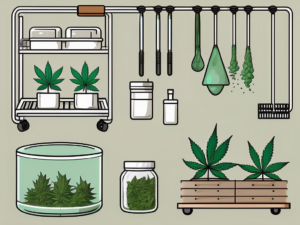Why optimizing the biggest expense in every cultivation can be the difference between a profitable grow or a failing enterprise.
We all know that feeling we get at the end of the work day. The clock is counting down to the end of your shift, and you’ve finished everything you were supposed to do in the grow that day.
You think – well, I’ve only got 30 minutes left, maybe I’ll go chat with the trimmers, or do some scrolling in the bathroom for a bit. I don’t even know what to do next anyways.
For every commercial cannabis cultivation, labor is always the biggest cost. So optimizing time spent in the grow is mandatory if you want to run a successful business.
This article details a few steps you can take as an owner, manager, or team lead to systematically create a framework to help decrease, or eliminate wasted time in the grow.
The real problem in commercial cannabis cultivations
When someone doesn’t know what to do next in the grow, it’s not usually their fault. If they’re waiting on someone else to tell them what to do, then the default response for most people is to jump on their phone or find some other way to spend time while they wait for a manager to line them out.
The problem here isn’t a lazy worker, it’s a breakdown in communication between what management wants to be done next, and the growers knowing that they need to do it.
How do we fix it?
For every grow we’ve worked with (a lot of them), there are also as many different ways to set up a successful line of communication between management and growers, and also grower to grower.
So, instead of telling you, the reader, what to do (which we don’t believe in) I’d like to talk about the communication issue in a general sense, or from a first principles thinking point of view.
Below is a framework broken into three topics – onboarding, systematic communication, and feedback. If you can get these three things right, you’ll limit the amount of the dreaded wasted time that can end up hamstringing a business, and watch your business thrive.
Employee onboarding - educate early to set expectations.
Going to move outside of cannabis for a moment to tell a story. Don’t worry, I promise I’ll make it relevant.
Coinbase, one of the world’s biggest crypto exchanges, is an extremely successful company that’s been around since 2012. Starting out as a small startup, they recently went public, being valued pre-IPO at a hair shy of 50 billion.
Looking at that growth, they had a lot of growing pains (just like any cultivation will have as they scale, add more canopy and harvests, and more employees).
Their growing pains came to a head and boiled over in 2020. This is the cliff notes, but there were quite a few people at Coinbase who became activist employees. They started to voice their opinions about the company, and politics, and anything else they had a gripe about, in a company Slack channel they created. Over time it got out of hand, distracting the entire company from what they were there to do.
In response, Brian Armstrong, the CEO put out this blog lining out exactly what Coinbase’s mission was (basically outlawing talk of politics and other things at work) and offered a generous severance package to any employee that didn’t agree with the newly defined mission.
In the end, the unhappy employees left, and those who stayed breathed a sigh of relief that they weren’t expected to have political opinions required at work.
I promised I’d related this back to the cultivation: The mistake Coinbase made was not onboarding employees thoroughly, and telling them exactly what they needed and expected from them. This lack of expectation setting is what led to their problems later on.
The same thing can happen in a cultivation. If you don’t properly onboard each grower, they won’t have a clear picture of what’s expected of them. If they don’t know what the standard is, they can’t strive to meet it.
For your commercial cultivation, onboarding each employee is essential. Making sure a new hire knows exactly how your unique harvest schedule works, what your SOPs are, and even how to dress (we hate mites too!), allows them to get off on the right foot before they ever enter the grow.
Over time, this initial education, and expectation setting will carry over into everything else they do in the grow.
Systematic communication - standardize how you'll share information in the grow.
So, we’ve educated our growers on how we grow, and we’ve got expectations set for them before they start on day one.
Now, you have to assume that every single new hire (and even veteran employees) will have to be told what to do, and how to do it for a given task, five or six times before they really understand it. Repetition leads to mastery, as they say.
There are a few ways to go about this. I’ve seen grows where they have a roaming manager that’s always available for questions, anywhere in the grow. I’ve also seen handbooks that growers keep on them all the time with specific SOPs written up in them for each process. Mostly, I see grows that have no intentional system to communicate, and everyone is always texting, calling, and running across the grow to see who’s doing what, and figure out what they’ll do as well.
That’s not efficient. Time wasted=failed business. Labor is always your biggest expense, and wasted time, or poorly done work are always your biggest issues in the cultivation.
Putting on my first principles cap here, I’d like to highlight there’s no right solution. It depends on the size of your grow, how many employees you have, and your own strengths as a manager.
What I can say is you have to have some kind of consistent system for how you communicate. Whether that’s the roaming manager, whiteboards in each room with the task list for each day, or cultivation management software that helps show each grower their task list for the day, and helps fill the gap on communicating work.
Whatever you choose, there’s a lot that goes into any communication system. A few must-have criteria we’ve found after consulting with our grows:
- Standardize vocabulary – always talk about each task in the same way
- Make communication consistent – have meetings at the same time every week. If you have a whiteboard, keep it in the same spot in the grow.
- Assign the same work to the same teams, every time – this might not work for smaller grows, where everyone does everything. For bigger cultivations, however, having teams that only deal with certain parts of the harvest creates better expertise for that work.
Accountability - give feedback to reinforce positive change over time.
To recap again, we’ve got our onboarding done, expectations set, and a good system to communicate those expectations.
The only missing piece at this point is also the most important – how to show your growers whether they’re doing a good job, and give them feedback so they can improve, or refine their expertise in the grow.
Again, a systematic approach is useful here too. One of our favorite grows to work with is Clarity Gardens out of Denver. Clarity has employee reviews every month. Because they do such a good job educating and training their growers, the review starts off with the question – what do you need help on?
This is a really intelligent way to go about things. The grower already knows everything they’re supposed to do, so if there’s a gap in their training or something they want to get better at, it’s clear to them, and they can get the specific help they need.
What these reviews also do is help drive accountability over time. The grower knows they need to be prepared for the review, knowing it’s coming monthly, which encourages them to think about everything that’s required of them, and think critically about where they might need help to improve.
For Clarity Gardens, the cultivation also used our task-management portion of the platform to drive accountability in those meetings. With PlanaCan, they can assign each task for every harvest, and then look back over time, to see exactly who did what, even if someone else was assigned to the task originally. These employee reports are key in how they collect metrics to assess each person in their cannabis cultivation.
So, what have we learned?
First, let me say again, that growing is hard. It’s also complex, and depending on your facility and process, unique to you especially at a commercial scale. While that’s always true, some constants apply to all businesses, and that’s what I tried to cover in this article.
To recap: Strong onboarding leads to a well-trained employee from the get-go. Setting expectations for exactly what you need from them will minimize issues later.
Next, you have to reinforce that training, through systematic communication. Having repeatable, and easy to understand ways of communicating day-to-day will absolutely revolutionize how your grow operates.
Last, you need to create accountability with every employee. Having feedback helps them think critically about what they need to improve upon, and also gives them confidence in what they’ve already mastered.
There’s a lot more I could’ve covered in this article. We’re obsessed with operations management at PlanaCan, but I’ll save other thoughts on the topic for a different blog.
Bottom line – wasted time in the grow is a business killer. If you want to drive plant growth, and watch your business thrive, try implementing some of the frameworks above. I guarantee you’ll see a positive change in your cannabis business over time.
Cultivating with PlanaCan
At PlanaCan, we make purpose built software to help commercial grows manage everything that happens in their grow. If your interested, reach out to us. We promise we can help with everything we detailed in the article above. We’ve got buttons all over the site to get in contact with us 🙂



